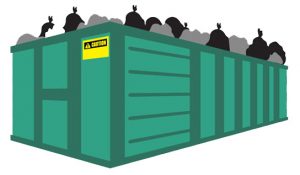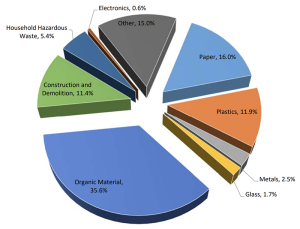 (Editor’s note: this story was updated on August 8, 2022.)
(Editor’s note: this story was updated on August 8, 2022.)
By Alice Waugh
Before there was a transfer station and before most people had heard of recycling, Lincolnites either burned their garbage in their back yard or brought it to the landfill, a.k.a. the town dump. The grassy hill with white gas vent pipes on your right as you enter the transfer station is all you can see of Lincoln’s landfill since it was closed in 1986 and capped in 1990.
Also in this series:
- Part 5: The 5 R’s, and some numbers
- Part 4: Recycling beyond the transfer station
- Part 3: Recycling beyond single-stream
- Part 1: Single-stream recycling
The Massachusetts Department of Environmental Protection (MassDEP) introduced its first bans on landfilling and combustion of easy-to-recycle and toxic materials in 1990. More waste bans have been added over time, so there’s now a growing list of things that aren’t allowed in municipal solid waste (MSW), otherwise known as trash.
Lincoln’s transfer station has two trash dropoff containers: the compactor next to the singe-stream recycling bin, and the one across from the new swap shed where you can toss larger items directly from your vehicle. That container used to be called the “commercial hopper,” DPW Office Manager Susan Donaldson said. The town no longer accepts commercial or construction waste; now everything in there goes to the same place as the regular trash.
There are some changes on the horizon for trash at the transfer station. The DPW is awaiting delivery of the new compactor and hopes to have it installed by the end of the summer.
Also, the so-called commercial hopper will be locked all the time, so residents will have to ask an attendant to open it when they want to drop items inside. “You’re not going to be able to back up and throw anything and everything into it any more,” Donaldson said. That move is an attempt to reduce trash “contamination” — meaning prohibited items that were thrown into the trash and should be recycled or disposed of in some other manner instead.
This is actually a bigger problem than the reverse (too many nonrecyclable items contaminating the recycling bins). The town has been getting warnings from WM (Waste Management), which picks up the transfer station’s trash and takes it to a waste-to-energy (WTE) facility operated by Wheelabrator in North Andover, one of seven in the state. Companies can refuse to accept MSW loads that contain more than 30% contaminants — meaning not food or chemicals, but rather items that aren’t allowed in the trash any more.
Because the trash from Lincoln’s two current containers are brought in separately, it’s been easy to see that most of Lincoln’s trash contamination is coming from the gated container rather than the trash compactor next to the single-stream recycling bin. Lincoln was also fined about a year ago after someone threw tires in that bin. Tires are not accepted any place at the transfer station and must be recycled by a service station.
So what happens to the trash?
When the trash is burned in Wheelabrator’s WTE facility, it yields electricity and heat but also some air pollution in the form of toxic chemicals. The federal government requires advanced pollution control equipment such as scrubber systems that reduce but not eliminate emissions. Each WTE facility in Massachusetts has to submit an emissions control plan as well as a report on the composition of the trash it takes in (click here for the facility’s latest report).

Residential waste by category that was processed by Wheelabrator in North Andover in 2019. (Source: “Wheelabrator North Andover, Inc. 2019 Waste Characterization Study Report in Support of Class II Recycling Program,” page 17.)
In 2019 (the last year for which a report is available), the largest category of trash at Wheelabrator in North Andover was organic material, which includes food waste, branches, stumps, smaller yard waste, and manure. Because of its relatively high moisture content, food waste takes more energy to burn than it yields, and it’s also one of the heavier components of household waste, which is a financial issue since the town pays by the ton for trash hauling. However, the transfer station has accepted compostable material since 2019.
Anywhere from 10-25% of incinerated trash winds up as solid bottom ash. Wheelabrator takes it to the Peabody Monofill Associates Ash Landfill, which accepts ash from several waste-to-energy facilities in the northeast United States. (Researchers are also investigating ways of extracting metals and minerals from bottom ash, or using it in making concrete or as a road base.)
As of 2020, Peabody was one of only 19 landfills still in operation in Massachusetts; another 942 MSW landfills and dumping grounds have been closed over the years, and most are or will be capped, or covered to minimize the percolation of stormwater through the buried trash and into groundwater and wetlands.
Though there are a lot fewer landfills nationwide than there once were, they still emit carbon dioxide and methane, a potent greenhouse gas. Landfills accounted for about 15% of methane emissions in the U.S. in 2020, according to the Environmental Protection Agency, which notes that methane emissions from landfills that year were roughly equivalent to the greenhouse gas emissions from about 20.3 million passenger vehicles driven for one year. As of 2022, there were 13 landfills in the state that are current or potential candidates for the EPA’s Landfill Methane Outreach Program that aims to harvest landfill gas for energy, but Lincoln’s is not one of them.
Not allowed in Massachusetts trash:
- Asphalt pavement, brick and concrete
- Cathode ray tubes
- Clean gypsum wallboard
- Commercial food material (lower threshold effective November 1, 2022)
- Ferrous and non-ferrous metals
- Glass and metal containers
- Lead acid batteries
- Leaves and yard waste
- Mattresses (effective November 1, 2022)
- Recyclable paper, cardboard, and paperboard
- Single-resin narrow-necked plastic containers (click here to see what becomes of Lincoln’s recycled plastics)
- Textiles (effective November 1, 2022)
- Treated and untreated wood and wood waste (banned from landfills only)
- White goods (large appliances)
- Whole tires (banned from landfills only; shredded tires acceptable)
Coming soon: Articles about what happens to these other recyclables — and what to do about stuff that the transfer station doesn’t accept.
Did you mean “not allowed,” not “now allowed”??
Never knew I would be so excited about where all the trash goes.
Still, It’s good to know about everything in the world from trash to cash!
Great article.
I spent a long time living in an area with trash collection and I never noticed when dumps disappeared. When I was a kid there was a huge pile of trash with seagulls circling overhead.